What is 4WD? What is 2WD? Can someone explain the difference between all-wheel drive, part-time four-wheel drive, and full-time four-wheel drive to me? I’m having trouble visualizing how they work.
4wd cars are best for people who live in areas with bad roads or people that like driving through puddles. If you want to buy one here’s what you should know:
The majority of these vehicles require no additional input from the driver (apart from selecting a gear with an extra high number) and therefore drive like a normal car.
However, 4WD cars can still be made to work in difficult conditions when extra traction is required – such as when driving over sand or mud. In these situations, the front and rear axles are connected by a transfer gearbox which sends power from one axle to the other when needed. This ‘on demand’ feature gives 2WD vehicles a huge advantage.
The difference between 2WD and full-time four-wheel drive? A 4wd car with a big button in the center console that you have to switch on every time you want to use it. Full-time two-wheel drives have permanently engaged drive-lines so they only have two driving wheels at any one time.
Full-Time VS. Part-time Four-Wheel Drive
When it comes to choosing a 4WD, there are two types: Part-time four-wheel drive and full-time two-wheel drive. What’s the difference?
Part-time 4x4s can be switched to “2H” or 2HI” mode, whereby the front and rear driveshafts are disconnected from each other; resulting in one driven axle instead of four. This allows you to use all four wheels when needed and switch back to 2WD when conditions allow – such as on tar road. These models will not allow switching into AWD unless they’re already in “part-time”, often resulting in possible damage to the drivetrain.
Full-time four-wheel drives, on the other hand, are exactly what they say on the tin – they are always ready to leave the driveway with all four wheels providing traction. The switch between 2WD and 4WD is not necessary as there are no front or rear driveshafts to disconnect.
These cars tend to be more expensive but for good reason; there’s less that can go wrong because you don’t have any switches or cables that fail after the time. You also don’t have to remove your hands from the steering wheel when driving over bumpy terrain. However, these cars will cost you more at the petrol station because of their high fuel consumption rates – especially when in 4WD mode.
For those of you wondering this; this is why they call it full-time four-wheel drive.
5 Reasons to Choose a Part-Time 4WD Vehicle:
1. They are significantly cheaper than their full time counterparts
2. You don’t have to lift your hands off the steering wheel when driving over bumpy terrain – especially helpful on our office roads!
3. Loading up the back with friends or family? No problem! You can still fit more people into your car without having to buy a bigger one. Try that in a pair of high heels! The larger boot also makes a nice change from taking the basket out (and having to walk home).
4. They’re perfect for day trips and holidays – here’s why: If the tires are not making contact with ground or sand, they will not wear down as quickly which saves you money in the long-term. You also avoid getting stuck in mud after driving through a puddle (guilty!) because there is no need to turn your car into a 4WD.
5. Don’t like driving through puddles or on muddy roads? No problem! You can still switch into 2WD mode whenever it suits you; we all know that driving over large bodies of water is bad for cars and causes rusting if done too often. So don’t do it unless you absolutely have to.
5 Reasons to Choose a Part-Time 4WD Vehicle:
You never get stuck when driving over wet or bumpy terrain; it’s what they’re designed for.
No need for extra switches – it does everything automatically and saves you battery in your car (and your time). More importantly, no buttons that can break! This is especially helpful if you live in a region where the weather conditions change rapidly; the last thing you want is a broken 4WD switch when it’s raining cats and dogs outside! So save yourself the trouble and spend more money at one go instead of repair costs later on…
No need to lift your foot off the accelerator – the car will do the work for you.
You can help Mother Earth by avoiding extra fuel consumption because of having to switch between 4WD modes all the time. As we mentioned earlier, this option results in higher petrol costs so avoid it unless you absolutely have to! If you’ve ever tried driving a manual car through water, there is no comparison; full-time 4WD will always win!
Stability and safety – if one drive axle loses its grip on slippery surfaces (or worse still, both), slipping wheels could cause an accident. Better safe than sorry (and be stuck with the insurance bill). No one wants that especially if it’s raining outside… not even your Aunty Mavis!
So there you have it, ladies and gentlemen. The next time you drive to the shops on a rainy day, remember these things before switching from 2WD to 4WD. Sometimes it’s better not to take risks! If ever in doubt, call your friendly car mechanic for advice – they’ll know what’s best to do when faced with a slippery surface. We hope you enjoyed reading this article as much as we enjoyed writing it.




